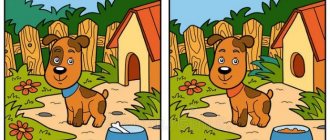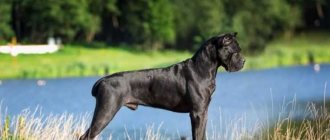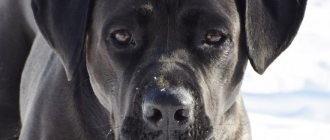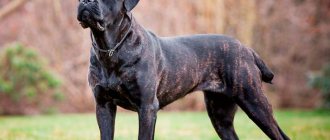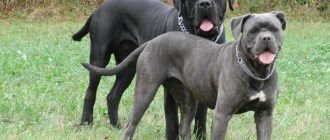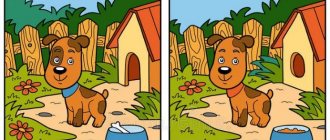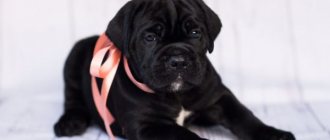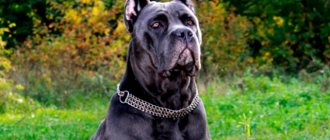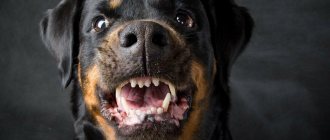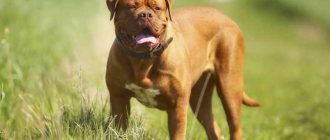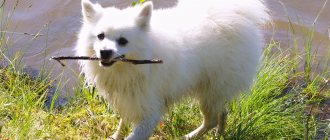When considering the Cane Corso, the description of the breed and the history of origin have a lot of interesting facts.
This dog is rightly considered the pride of Italian dog breeders.
After many years of “disgrace”, she gained wide popularity, which is facilitated by her special affection for her owners, good disposition and ability to perform official duties.
Given the huge demand, puppies have sharply increased in price, and therefore the choice must be made carefully and carefully, with knowledge of the characteristics of the breed.
Historical reference
The history of the appearance of the Cane Corso breed is associated with Ancient Rome.
Its ancestors are considered to be Molossian dogs, descended from the fighting dogs of Persia and Carthage, the mastiff-based breeds of Macedonia.
Ancient dog breeders specially bred this breed for guard and combat service, and therefore special attention was paid to its large size, devotion and lack of fear..
In addition to military specialization and gladiator fights, dogs took a worthy part in hunting large animals (even lions).
Along with the decline of ancient Roman civilization, Cane Corso also fell into disgrace.
The new nobility considered her insufficiently aristocratic and rustic. As a result, the dog ended up in the provinces and rural settlements, where they did not care about the purity of the breed. Previously, a single breed, due to various arbitrary mixings, was divided into several subspecies, losing many of its characteristic features.
Interest in the Cane Corso was restored by the Italian researcher and passionate dog lover Breber..
Only in the early 90s of the last century was he able to interest professional dog handlers and prove the right to exist of this breed as an independent species.
In November 1996, this status was officially approved. In 2003, the breed standard came into force.
The undeserved oblivion ended, and the Cane Corso became the pet of politicians, businessmen, and artists..
Character and temperament
To fully understand the character and temperament of the four-legged Cane Corso breed, we will have to plunge a little into the history of the origin of these dogs. The first mentions of this breed are found in ancient Roman chronicles. At that time, large and muscular dogs were used as so-called poisoning gladiator dogs.
Probably for this reason, representatives of this breed are often called fighting dogs. However, thanks to their endurance and performance, dogs began to be used in various spheres of life, in particular for guarding livestock and performing guard duty. Today, the Cane Corso dog is chosen as a reliable guard and faithful companion. They respond well to education and training, during the learning process they show calmness and balance, and readily carry out the tasks assigned to them. Training a Cane Corso is a way to suppress excessive aggressiveness, as well as develop social and territorial instincts.
Animals get along well with their owners; out of all family members, one is usually singled out. They are characterized by obedience and restraint. By leaving your pet alone in the house, you can rest assured that the dog will not cause any harm or start misbehaving. Despite the playfulness that is inherent in both Cane Corso puppies and adult dogs, four-legged dogs will not play dirty tricks in order to attract attention to themselves.
Nevertheless, these dogs really love the care of their owner, communication with him, active games and walks in the fresh air. With a lack of attention, the dog begins to mope, as a result of which it may even get sick. This breed is often called aggressive. In fact, they are friendly and reserved dogs that get along well even with children. Cane Corsos can be negative or neutral towards other animals living in the same house as them. In order for the pets to quickly adapt and get used to each other, it is necessary to start raising the Cane Corso as soon as the dog crosses the threshold of your home.
Related article: How to choose and name a Cane Corso puppy
Character traits
The breeder described the character of the Cane Corso dog quite clearly:
Expert opinion
Kozhevin Semyon Kirillovich
Expert dog handler.
“The Cane Corso can be safely called a very intelligent and smart dog, combining natural power and amazing nobility. She has a balanced temperament, without unjustified aggression. This dog will never offend anyone without a good reason. At the same time, she is able to stop any intruder who invades her domain, be it an animal or a person. There is no arrogance or ostentatious aristocracy in her, but a living soul is visible.”
The character traits of the Cane Corso have evolved over the centuries taking into account its main purpose - the protection and protection of a person and his possessions..
It can be considered a classic example of a guard dog. She embodies sedateness and poise, calmness and complaisance with full confidence in her abilities and enormous internal energy.
The Cane Corso is always ready to repel any threat to the owner and family members, even risking his own life.
She has an important ability - a clear division of everyone into friends and strangers (both people and animals).
NOTE!
The dog always vigilantly controls the situation, and at the first threatening movements of a stranger, it shows its readiness.
It is impossible to bribe her or distract her attention with any treats.
She always remembers her responsibilities. In case of a direct threat, it can act without the owner’s command. At the same time, her intelligence allows her to distinguish between real and imaginary threats, true danger and games.
A dog's devotion to its owner has no limits . Since puppyhood, she has been selflessly devoted to him. Ready to follow any commands and always be with him.
It is very difficult for him to survive long separations, and he may not survive betrayal at all. It takes a very long time to get used to the new owner and with great care.
Cane Corso has a special attitude towards children . A very developed parental instinct forces her to protect everyone who is smaller and clearly weaker than her. She is a faithful friend for the owner's children.
The dog also takes strangers under its wing. She lets the kids do whatever they want with her. As a last resort, she will simply quietly move away and hide.
A Cane Corso will never hurt a child . The dog is aware of its growth and strength, and therefore is very careful with small children. Children's crying is a real punishment for her.
The attitude towards other animals depends on whether they are our own or strangers. The Cane Corso gets along well with other pets in his own home, recognizing them as his own.
She is able to be friends with cats, parrots, turtles, small breed dogs and other animals. There are no problems at all if she met them as a puppy.
The attitude towards other people's dogs and animals is complex . The Cane Corso does not attack first, but if any aggression is shown by a “stranger,” it is capable of serious action.
In general, Cane Corso dogs are versatile animals with developed intelligence, quite agile, good-natured with a persistent character. They happily follow commands.
They love fun games with children and adults, but are unobtrusive . A dog needs emotional contact with its owner and other family members. They love company, but only speak on command.
Is this breed suitable for keeping in an apartment? Of course, any large dog needs a decent area, and the ideal condition is its own yard or plot.
However, the Cane Corso feels great in the apartment . If you give it its own small corner, then it will not cause inconvenience to the residents, despite its size.
CHILD AND DOG
Raising a child and a dog in the same family is a masterly task.
Perhaps, if you do not have experience communicating with dogs, it will be difficult to do without consulting specialists. However, if you have the opportunity to choose the right breed, as well as the time and desire to take care of the dog, there is a very good chance that the child and the dog will become friends and adore each other.
The main thing you need to remember is that the dog is not another child of yours. If you treat it the same way as you treat your children, then you are guaranteed bad behavior from the dog.
The dog does not know how to fulfill the social attitudes that your child learns from the first years of his life; even when he is in the human world, he lives according to the laws of the dog pack. In addition to the fact that you have to prove to her your primacy, your right to be the “leader,” you have to teach the child the laws by which the dog lives and on the basis of which its behavior can be predicted.
Quite often, parents get a dog, giving in to the child’s obsessive requests, saying “only you yourself will walk”, “only you yourself will feed.”
Of course, that doesn't happen. The child is ready to share responsibility for the dog with his parents, but not to take it entirely upon himself. Therefore, so that the new family member does not become a cause of discord, think carefully about whether you really love dogs, whether you have time to seriously engage in a dog and its upbringing.
Yes, yes, even non-exhibition specimens require education, otherwise they grow up to be real leaders of the “pack”, domestic tyrants, in front of whom the whole family walks on tiptoe.
Books, forums and our article can help you.
We will not consider health and hygiene issues here, but rather focus on psychological subtleties.
Babies – small child and puppy
They say that in old England, when a child was born, the parents got a puppy, another one was born, and they got another one. So that the child grows up with the puppy, he is his companion.
First of all, to get a puppy, you need to wait until your child is at least 1.5-2 years old. Although, probably, recommendations here are unnecessary, it is unlikely that anyone would think of purchasing a puppy earlier.
The recommendations when you have two children growing up at home are simple - do not leave these two unattended. Neither one nor the other has yet measured their strengths and poorly understands the reaction of the other, and this is fraught with injuries, both physical and moral.
Also teach the puppy not to touch the child’s toys and vice versa.
The puppy, of course, will mature before the child and at some point will “take charge” of him. But then, when the child is 6-9 years old, it is likely that the balance of power will change and the dog will accept him as an equal, then they will become real friends. Of course, this depends on you - you should not shout at the child, or somehow infringe on him in relation to the dog (and this happens), and on the child himself, his participation in the dog’s life, understanding of the dog’s psychology.
Tailed Nanny - an adult dog and a small child
This situation is quite typical - a young couple has a dog, and then a child is born. Very often, people who are far from the world of dogs and dog lovers are generous with horror stories and advise getting rid of their four-legged friend for the benefit of the baby. However, the situation can be resolved without anyone getting hurt.
Of course, the arrival of an infant at home requires more careful hygiene. Conduct deworming in advance, and you also need to check and, if necessary, remove fleas. Dog hair should be regularly combed and wiped with a damp towel.
As a rule, dogs that have been properly raised take the arrival of a small family member easily. There are many examples of such touching care on the part of four-legged animals that they can be called real nannies. For example, a dog can guard a baby's sleep and call its owners when the little one wakes up. Or comfort him when the child cries.
This behavior of the dog means that the dog considers your baby to be a junior member of the “pack”, that is, he believes that he should be taken care of, protected, and there is little demand for such a baby. Dogs treat their puppies in much the same way. However, dogs often punish puppies. So when your child gets out of infancy, you should first monitor how your dog reacts to the child’s desire to pull his tail or pull his ears.
However, there is a situation when the dog does not react in any way to the appearance of a child in the family and does not even come close to him. You should not force her to communicate with the child. In this case, the relationship between the child and the dog will improve at some level over time, but if you force the dog into contact with the baby, then there is a possibility of hostility.
Unfortunately, there are also cases of painful jealousy on the part of the dog. More often this happens with male dogs, and in those cases where, before the birth of the child, they were in the family as a “baby”, they were pampered. Of course, leaving a dog unattended next to a child in this case is unacceptable. Of course, the dog should be severely punished for any manifestations of aggression towards the child. However, if you only punish, the dog will become even more angry. It is imperative to encourage the correct attitude towards the child, the manifestations of which will also happen from time to time. We also recommend that you contact professional trainers for advice, because the dog’s behavior can be corrected even in adulthood.
Raising with love - an adult child and a puppy
An adult child, without a doubt, can help you fully manage the puppy, and this will be his first experience of caring for a living creature and being responsible for it. So carefully monitor the relationship of this couple, adjust them as problems and conflicts arise.
A child can either become truly passionate about raising and training a dog, or become cold towards the puppy to the point of completely ignoring it. Therefore, you need to think over your own behavior strategy.
First, let your child be involved in choosing the breed and choosing the puppy itself. If a child really likes a dog, he will be more enthusiastic about caring for it. If your child brings a puppy from the street, you should think about this option (of course, if the topic of acquiring a dog has been discussed in the family), but immediately take the dog to the veterinarian.
Secondly, you should explain to the child that the puppy has a daily routine. If the child himself has such a routine, then this will not cause misunderstanding. The dog needs to be fed regularly, exercised, cleaned up after it and taken for walks. Perhaps you will divide these concerns equally. In any case, try to distribute them evenly so that the puppy does not cause associations with the toy in the child, which will certainly happen if he only plays with it.
Thirdly, watch how the child interacts with the puppy. Unfair punishments by a child towards a dog should not be allowed, just as a relatively adult puppy should not be allowed to behave aggressively towards a child. Tell your child about the psychology of dogs, help him understand the behavior of a puppy.
Gaining trust – adult child and adult dog
Let's say you have an adult dog, and your nephews come to visit you. Or friends with children came in. And children, which is completely natural, want to communicate with the dog.
If your dog cannot stand children at all, and this happens, then you should simply lock him in a separate room, otherwise such communication can end very badly.
If your dog is friendly and patient, all you have to do is give the children a short lecture about the rules of behavior with a dog. Any dog uses a number of signals to understand how it is tuned.
Dogs cannot tolerate sudden movements near their muzzle, hugging, chaotic patting on the body and loud screams. A well-mannered dog can allow this behavior, but it will get tired pretty quickly. Then she will try to simply step aside. If she is not allowed this, this is usually followed by the so-called “signals of reconciliation” - the dog yawns widely or licks his nose, turns his back, freezes for a while without moving at all. If the child does not stop his “harassment” even after this, the dog will quietly growl at him. If he does not heed this signal, the dog will begin to growl louder, dully and threateningly, at the same time twitching his upper lip and showing his teeth. If this does not have an effect, the dog will bite. Agree, in this case her behavior cannot be described as “unexpectedly attacked.”
And it’s a completely separate issue when an adult dog is adopted into a family with an adult child. Let your child participate in training the dog along with you. He should feed her, communicate with her. If the dog is large, then you should not send the dog for walks with the child at first; he will not be able to control its behavior.
Advantages and disadvantages
Among the positive qualities of the Cane Corso, the following characteristics stand out::
- attractive, stately appearance, prestige;
- watchdog abilities, selflessness in protecting the entire family and property;
- absolute devotion to the owner;
- love of children and ability to get along with other pets;
- ease of hair care;
- tendency to train.
When choosing this breed, you must also take into account the presence of some negative aspects.:
- significant size and strength require proper training;
- a tendency to lead, requiring certain strong-willed qualities and patience from the owner;
- need for long walks (at least 2 hours a day);
- a sufficiently large volume of the daily diet;
- drooling;
- tendency to articular dysplasia;
- high cost of puppies.
Despite the presence of disadvantages, the positive qualities of the breed outweigh, and the Cane Corso has gained wide popularity.
She began to be considered a fairly prestigious and fashionable dog.
Tips from a dog handler
Raising and training a Cane Corso dog requires a lot of time, effort and desire. To ensure that the lessons are not in vain, we bring to your attention several training secrets used by professional dog handlers:
- You need to raise a dog from birth or from the moment the pet appears in the house.
- Initially, you need to show the animal who is in charge in the house.
- Do not succumb to the manipulation and provocation of a dog who will not have the desire to follow commands.
- Any exercise should begin and end with a clearly formulated command. Don’t forget to praise and treat your dog with treats for each command he completes.
- During the training process, use Balabanov’s technique, which involves a combination of active and passive actions of the animal during play or performing a given task.
- Mutual understanding between the owner and the dog is the basis for raising and training the Cane Corso.
Related article: What you can and cannot feed your Cane Corso dog
Characteristics of the breed
The breed standard normalizes the basic parameters that the animal must meet.
The Cane Corso belongs to the category of large dogs with powerful, well-developed muscles..
The proportions are characterized by a slightly elongated shape - the length of the body is greater than the height at the withers.
Such characteristics are standardized:
- The weight of a Cane Corso should be between 44-49 kg for a male and 39-45 kg for a female.
- Dimensions: height at withers for males – 63-67 cm, for females – 59-63 cm.
- Color variants of the breed. Cane Corso can be black, gray and red in different shades or brindle. There may be light spots on the paws and chest area. Red and brindle individuals have a dark-colored mask on their heads that extends over their eyes.
- The coat, regardless of color, is short and shiny, with no undercoat.
- Life expectancy with proper care is 10-12 years.
Adult dogs have a characteristic appearance. They are distinguished by a massive, slightly elongated head with a wide convex forehead. The body looks strong with a well-developed, wide chest area.
Ears and tail are most often cropped at an early age (the photo shows a Cane Corso with cropped ears).
Nuances of maintenance and care
The Italian Mastiff is an unpretentious dog, but certain rules for keeping and caring for them must be followed.:
- Dogs do not tolerate cold well. When kept in the yard, they need an insulated booth. Puppies should be kept in a warm room.
- The dog's physical activity is quite high. Walks should be long (at least 2 hours a day) with active games and running exercises. Playing together with other large dogs is desirable.
- Wool does not require special care. It should be combed periodically (at least once every 7-8 days) with a brush with natural, hard bristles. If necessary, flea and tick treatment should be carried out promptly.
- Constant ear hygiene is required. It is necessary to carefully check the ears and clean them.
- It is recommended to use special preventative chewing bones to clean your teeth.
- As the nails grow, they are trimmed.
If your dog gets dirty, you should clean the coat immediately after a walk. Bathing is done as soon as it gets dirty, but at least 2-3 times a year.
CAREFULLY!
Bathing too often is not advisable, because... wool may lose its protective properties. When bathing, special shampoos are used.
Cane Corso: features of the breed
- Balanced and flexible psyche.
- Devotion and boundless love for the owner.
- High intelligence, easy to train.
- Desire for protection and care.
- Excellent security and protection.
- Strong and resilient.
- Can be kept in an apartment.
- Stubbornness can lead to problems in training.
- Profuse salivation.
- Excessive pet affection. He will follow you everywhere and always, you will not be able to take a single step without him, he will never leave you alone - you are provided with round-the-clock security. Even your short absence will be a tragedy for the dog. Do not forget that all these are just the consequences of his boundless love for you and the fulfillment of his direct duties - the Cane Corso is, first of all, an ideal bodyguard who does his job without breaks or days off.
- Representatives of this breed have one more negative property - they put into their mouths and swallow everything they find. This often leads to trips to the veterinarian and operations. But not everything is so scary: your pet can be rid of this habit through education and training, the main thing is to start doing this in a timely manner.
- Due to its short fur, it is not suitable for outdoor or aviary keeping.
- Quite an expensive dog to keep.
- Requires mandatory training.
Nutritional Features
Any large dog needs a sufficient supply of proteins, and their main supplier is meat. Therefore, the core of nutrition consists of meat and offal.
From puppyhood, she should be accustomed to dairy products, cereal-type porridges, vegetable and fruit additives . It is useful to give large bones. Raw meat can be used, but you should remember to prevent worms.
You should not give your dog fish with bones, especially raw fish. We must remember that raw river fish contains numerous parasites that can cause various diseases.
It is not recommended to give your dog smoke.
You should not get carried away with muffins, sweets and food high in carbohydrates.
You can feed your pet dry food, but it is better to choose premium food . Vitamins and minerals must be added to natural food, and their composition should be consulted with specialists.
Food must be fresh. Abrupt transitions from natural to dry food, and vice versa, are undesirable. They have too significant an effect on the dog’s gastrointestinal tract.
Read more about Cane Corso nutrition here.
Pet health
The health of the Italian Mastiff largely depends on genetic background.
One of the most common problems is femoral dysplasia, which develops in the hip sector of the canine skeleton..
Even in a mild form, the disease leads to lameness, and in severe cases, loss of motor ability is possible.
The pathology is very difficult to control and treat. The most effective way is to prevent the appearance of new offspring with this problem.
Dog owners conduct x-rays of the joint before the first mating . When it is detected, measures are taken to limit the birth rate.
Education and training
Raising a dog should begin from a very early puppyhood.
It is important to help the puppy learn about the world around him and perceive it correctly in different situations..
Already at this age, training goes in two directions - discipline and obedience, as well as professional, watchdog qualities. It is best to carry out education immediately with the involvement of a specialist.
A dog's normal character is formed in several ways . First of all, a good genetic code is ensured as a result of selection. One of the effective methods is imprinting.
It involves keeping the puppy with a trained mother for a long time. Through her example, he receives the necessary education. Another way is to socialize the dog.
Starting from 3-4 months of age, the puppy should have active contact with people and other animals.
Features of care, maintenance and training
the fenced area of the house suits him best . You shouldn’t leave a Cane Corso alone : although the dog is hardy, capable of taking care of itself on its own and withstanding any vicissitudes of the weather, it still needs attention and communication.
In order for the dog's temperament to be stable, the puppy must be socialized from an early age. She also needs sports activities. Therefore, it is unlikely that it will be possible to limit yourself to an hour-long walk. But this is an excellent companion for active walks and jogging.
The Cane Corso is unpretentious in food; as early as three weeks, the puppy can be gradually transferred to an adult diet. better than natural food for dogs has yet been invented.
Training is not particularly difficult either. The most important thing here is to let him understand that the owner is the leader of the pack. Then the Cane Corso will obey. It is enough to teach him the simplest commands, and then his intelligence will allow him to understand you on his own. And yet, a young dog should not be released into the forest without a leash: hunting instincts will take precedence over training.
The Cane Corso does not shed very actively, so it is enough to occasionally comb the dog and wash it once a year, as well as carry out preventative measures against ticks and fleas.
How to choose?
The choice of a Cane Corso puppy must be carried out with knowledge of the characteristics of the breed.
First, you need to decide for yourself the question of the purpose of the animal - whether it will be a guard and protector or just a kind, pet, to please only household members or to be shown at exhibitions.
Accordingly, the choice of dog is made taking into account the requirements.
You should purchase a puppy at least 8 weeks old, when he is already capable of full independent nutrition . His weight at this age should be at least 7-8 kg.
It is important to find out all the ins and outs of the parents and whether they have genetic problems. It wouldn’t hurt to clarify the number of individuals in the litter. The optimal option is 5-7 puppies.
Next, the physical and external characteristics of the puppy are checked according to the breed standard.
Cane Corso dogs older than 3 months should be taken with great care . They have a very hard time getting used to their new owner. In this case, specialist consultation and special care and attention to the pet are necessary.
How to raise a Cane Corso puppy
If you train your pet correctly, then over time you will get an obedient dog that will follow all commands and delight you every day. Experts believe that several factors may influence the Cane Corso’s susceptibility to following various commands:
- pet's temperament - the speed of the pet's reaction to stimuli, both positive and negative;
- character - how exactly the dog resists various unpleasant influences;
- obedience - the dog’s ability to accept human leadership;
- vigilance - the speed with which the dog notices potential danger, both in relation to itself and in relation to the owner;
- aggressiveness - the pet’s ability to react hostilely to potential danger;
- curiosity - interest that is developed when a dog feels, hears and sees something;
- sociability - the ability to interact with people;
- possessiveness is the interest shown by animals in certain objects, for example toys.
How quickly your dog will learn commands depends on which traits predominate in the Cane Corso puppy’s character. By paying attention to the character traits of your animal, you can find an approach to it and adjust its behavior in certain situations.
- Eagerness will get you nowhere . You should not try to teach your Cane Corso puppy all the commands at the same time; you need to learn the commands one by one. You need to have patience and act methodically. You should not scold your pet at the moment when he makes mistakes, and when he succeeds in something, then the pet should be encouraged.
- Don't hit . It is prohibited to use physical punishment against a pet until it is three months old. You should limit yourself to variable intonation, but avoid shouting. After the Cane Corso puppy turns three months old, it is allowed to use a light spank as punishment while saying the phrase “Ugh.” It is necessary to punish immediately when the animal commits an offense, and not after it, since the animal simply will not understand what exactly it was punished for.
- Subsequence . The main goal is to ensure that the pet follows the command the first time. Commands should be pronounced clearly and in an even voice so that the dog understands and obeys you. All family members should be involved in raising the dog, but they must act together. It is forbidden to allow situations in which you scold the puppy, and another family member praises him or simply does not pay attention.
- Pamper . Remember to reward your Cane Corso puppy with a variety of treats and praise when he has done what is asked of him.
How to name?
When choosing a nickname for his pet, the owner is free to show maximum imagination. You can remember the Italian roots of the Cane Corso and use something reminiscent of that country.
You can offer other ideas:
- For boys – Archie, Apollo, Albus, Arnie, Baron, Bucks, Wooddy, White, Thunder, Duke, Gore, Dexter, Jack, Dave, Georges, Zidane, Zeus, Crispus, Courage, Krief, Casper, Lyon, Lexus, Mike , Maurice, Nord, Nice, Norman, Oliver, Osman, Onyx, Parker, Prime, Rich, Rider, Ringo, Spartak, Stif, Snike, Sultan, Tyson, Teach, White, Walter, Frank, Hulk, Hallie, Caesar, Chief , Chip, Chase, Shah, Alvin, Ernie, Justin.
- For girls - Alma, Aisa, Angel, Barca, Beta, Bessie, Venus, Vicky, Gloria, Gizma, Dana, Diya, Zita, Zara, Ilsa, Irma, Cassie, Cleo, Keri, Lilu, Lucky, Molly, Maya, Nika , Nancy, Ollie, Piggy, Pixie, Roxy, Richie, Sally, Selina, Stacy, Tori, Terra, Ulli, Ulma, Fanny, Fiona, Flora, Chloe, Holdie, Tsara, Cessie, Chelsea, Sherry, Sheila, Elsa, Ellie , Yumi, Utah.
We must try to name the pet so that the nicknames do not repeat next to each other.
In addition, you should not use nicknames that are similar to the names of family members and teams.
